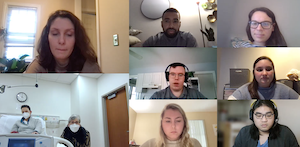
Students from WMed recently worked together with students from three other healthcare disciplines in a simulation environment to help prepare them for interprofessional practice during their careers.
The Interprofessional simulation was developed in 2016 by Diane Peirce, MD, an assistant professor in the Department of Medicine, and Debra Lindstrom, PhD, a professor in Western Michigan University’s Department of Occupational Therapy. It has run annually since. Held in a virtual format this year, the event allowed more students than ever to participate. WMed’s Class of 2024 participated along with more than 100 Western Michigan University College of Health and Human Services students. This year's event included physical therapy students in the simulation for the first time.
In the simulation, a patient who has suffered a stroke is nearing discharge from an inpatient rehabilitation facility. Medical students work with their fellow professionals-in-training as a team and with the patient and family to develop a discharge plan. For this exercise, the patient and family member are portrayed by standardized patients, Dr. Peirce said.
“We really want to have our students working together before they go on to residency and beyond so that they understand the roles and responsibilities of other health care disciplines,” Dr. Peirce said.
The event serves as a follow up to a previous simulation on acute stroke management developed by Richard Lammers, MD, professor in the Department of Emergency Medicine and the medical school's former assistant dean for Simulation. Medical students participate in the first event as M1s as part of the stroke call-down team that evaluates the patient in the emergency department and determines if the patient is a candidate for thrombolysis or clot-busting therapy. In the second phase of the initial simulation, participants see that the patient has had little improvement and the students focus on how to reduce future stroke risk factors and stress the importance of physical, occupational, and speech-language therapy to the patient.
“We’re all experts in our areas,” Dr. Lindstrom said. “The OTs need to be able to speak up for what’s going to help that patient.”
Dr. Peirce said it was important to keep group sizes small, so 36 interprofessional teams ran through the two-hour simulation, then debriefed with WMU and WMed faculty members. Six standardized patients were live in the Simulation Center at the medical school and each interprofessional team was able to interact with a patient and their sibling virtually.
Stroke care involves physicians, occupational therapists, physical therapists and speech-language pathologists, making the simulation a good vehicle for this type of training, Dr. Peirce said.
“Interprofessional education leads to interprofessional practice,” Dr. Peirce said. “If our students can learn to talk with each other when they’re still all at the same level, they'll communicate better and then ultimately provide better patient care. We have to work together as a health care team, and that is why interprofessional education is mandated in all of our disciplines.”
The simulation will continue to be held in a virtual format to accommodate as many students as possible, Dr. Peirce said.
M2 Deep Patel said the simulation made him think about what a patient’s life would entail after the emergent care is done.
“It helped us focus beyond what we would treat like in a classroom scenario,” Patel said. “You start thinking about what the patient’s life is like afterward and what you need to do for them. We got to discuss what therapy looks like for the patient and how often it happens.”
Being a part of a care team in the simulation gave M2 Cassie Bloch a better idea of what happens after the patient is out of a physician’s hands. It’s incredibly important for physicians to know what they are asking of other professionals when they refer a patient, she said.
“If the medical care is under control for the patient, we don’t have as much say,” Bloch said. “So much of caring for these patients is up to physical therapists, occupational therapists, and speech-language pathologists. The simulation was an interesting way to get to understand what paths our patients would take after we treated them and understand the limitations of our job."
